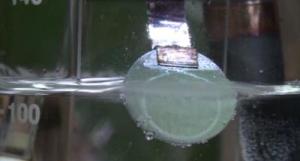Researchers at North Carolina State University have shown that a one-atom thick film of molybdenum sulfide (MoS2) may work as an effective catalyst for creating hydrogen. The work opens a new door for the production of cheap hydrogen.
 North Carolina State University researchers found MoS2 thin films are effective catalysts for hydrogen production.Credit: Linyou Cao
North Carolina State University researchers found MoS2 thin films are effective catalysts for hydrogen production.Credit: Linyou Cao
Hydrogen holds great promise as an energy source, but the production of hydrogen from water electrolysis – freeing hydrogen from water with electricity – currently relies in large part on the use of expensive platinum catalysts. The new research shows that MoS2 atomically thin films are also effective catalysts for hydrogen production and – while not as efficient as platinum – are relatively inexpensive.
"We found that the thickness of the thin film is very important," says Dr. Linyou Cao, an assistant professor of materials science and engineering at NC State and senior author of a paper describing the work. "A thin film consisting of a single layer of atoms was the most efficient, with every additional layer of atoms making the catalytic performance approximately five times worse."
The effect of the thin films' thickness came as a surprise to researchers, because it has long been thought that catalysis normally takes place along the edges of the material. Because thin films have very little 'edge,' conventional wisdom held that thin films were essentially catalytically inactive.
But the researchers discovered that a material's thickness is important because the thinner the MoS2 thin film is, the more conductive it becomes – and the more conductive it becomes, the more effective it is as a catalyst.
"The focus has been on creating catalysts with a large 'edge' side," Cao says. "Our work indicates that researchers may want to pay more attention to a catalyst's conductivity."
Cao developed the technique for creating high-quality MoS2 thin films at the atomic scale in 2013. The current production of hydrogen from the atomically thin film is powered by electricity. His team is working to develop a solar-powered water-splitting device that uses the MoS2 thin films to create hydrogen.